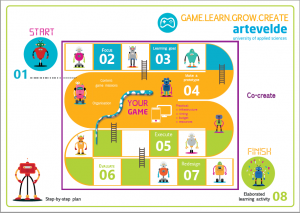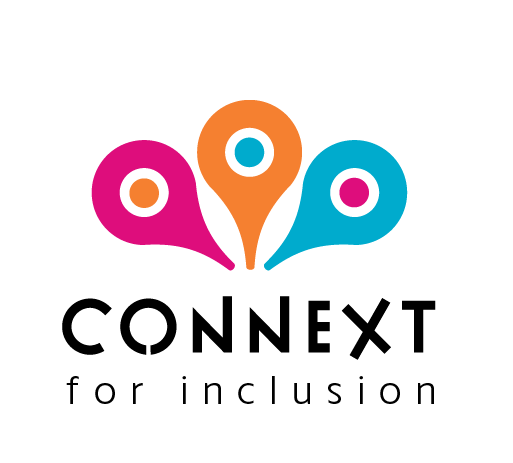When we implement games in the classroom or in other contexts, the role of the teacher or game master is extremely important. How you design the games, determines everything! That’s why in this article we focus mainly on the important question: how can we co-create and implement games in the best way?
Here we briefly go through the eight steps you can take in implementing a game. Using a design-based research procedure, Vanderhoven, Carrillo and De Latter (2018) developed a step-by-step plan called Game.Learn.grow. It has been tested and modified by the international partners of CONNEXT project. Based on their experiences, the importance of co-creation was so significant that its role in the process has been emphasised. Our updated model is therefore called Game.Learn.Grow.Create. and it can be used as a framework for game-based learning in different contexts.
STEP 1: MAKE AN OVERVIEW OF THE INITIAL SITUATION
Before you start, think about the initial situation of your group. Every class or group is different, every teacher or instructor is different and also every school or context is different.
Ask yourself the following questions about (1) the target group, (2) the infrastructure and (3) the context:
- Who will play the game (target group)?

- How is the group dynamics?
- Do the players have experience in playing (technological) games?
- How much support do they need?
- What infrastructure is available?
- In which context will the game be played?
- Informal? Formal education? Youth work?
STEP 2: DETERMINE THE FOCUS
Think about what you want to accomplish with the implementation of games. What is the question that has to be ‘solved’ and thus the focus for your design of a learning activity with games? It is good have dialogue also with the target group when determining the focus of the game.
Ask yourself the following questions
- What is the main focus of the game? Why do you play it?
- Learning goal?
- Personal goal?
- Group goal?
STEP 3: DETERMINE THE GOALS
Once you know the main focus, think about the different goals you want to accomplish. Specify them more concretely. Keep in mind: to work in a goal-oriented way, goals must always come first, no matter what resources, e.g. teaching aids, technological aids or infrastructure you will use.
Ask yourself the following questions:
- What are all the things you want to achieve with your target group?
- Learning goals
- What do they need to know after playing the game?
g. to learn something about the system of migration; education goals - What skills do they need to have after playing the game?
Also think about the 21st century skills (e.g. problem solving, critical thinking, self-regulation, ICT and new media skills, creative thinking) - Which attitudes are aimed at by playing the game?
- What do they need to know after playing the game?
- Personal goals
- g. to let the player feel more confident in applying for a job, learning more about themselves
- Think about: initiative, commitment and perseverance, discipline and punctuality, dealing with stress, flexibility, creativity & innovation, self-knowlegde (own motivation, strengths – weaknesses, preferences)
- Group goals
- g. getting to know each other, teambuilding, creating relatedness between groups, making connections / networks, communication, collaboration
- Other goals?
- Learning goals
STEP 4: CO-CREATE YOUR GAME ACTIVITY
Determine the game activity you want to work out, the content of the game, group organisation and evaluation. Remember to play the game elements with a test group that represent the target group. Co-creation can take place during the whole process of the game: at the start (input from the target group before making the game), during the making of the game prototype (feedback from target group) and/or and the end (as a test group).
Also think about your timing and your role as teacher or game master. In this step, also determine your resources, including the game platform that you will use. In the illustration of the game process you can see that there is an interaction between all these elements, and that they cannot be determined linearly. At the end of this phase you have a first detailed game activity.
Ask yourself the following questions:
- Which game elements and missions can contribute to the goals?
- What content is needed to accomplish the goals (step 3)?
- How does the input from target group direct your thoughts?
- What organisation is needed to accomplish the goals of the game (step 3)? g. should the game be played individually, in small or big groups, everyone simultaneously or at own pace
- What is your role as a game master?
Give clear instructions about the organization of the game. Think about:
✓ what is the role of every participant.
✓ how the results should be registered.
✓ what is expected once the game missions are finished.
✓ how the participants can ask for help
✓ how the group division is
✓ where to find the materials
✓ how to start and exit the game and reboot (if necessary)
✓ …
- How will you evaluate if the goals are accomplished?
- What resources and infrastructure are needed?
STEP 5: EXECUTE YOUR GAME ACTIVITY.
Execute your learning activity with your target group. In the meantime, carefully observe what is happening.
Ask yourself the following questions:
- Is everything going as planned?
- How do your participants respond?
STEP 6: EVALUATE YOUR GAME ACTIVITY.
Executing game activities doesn’t always go smoothly. It goes with trial and error. Therefore, always reflect on your game activity afterwards. Involve your participants in this phase to evaluate the game activity from different perspectives.
Ask the following questions:
- Goals:
- How are the goals achieved?
- Are there positive or negative unexpected side effects?
- What can be improved:
- technologically? Infrastructure?
- on the content?
- on the organization? Timing?
- in the instructions?
STEP 7: REDESIGN YOUR GAME ACTIVITY.
Really good learning activities are created by refining them. After playing the game several times, you will know better and better where to pay attention to and you will be able to enjoy the use of the games. Go back to the previous steps and rethink and redesign what is necessary. Every time keep your goals in mind when redesigning the game elements.
STEP 8: FINISH!
You have now a well-developed game activity that you can be proud of!
Text: Liese Missinne, Artevelde University College of Applied Science
Picture: Artevelde University College of Applied Science
Bibliography:
- Vanderhoven, E., Carrillo, L., & De Latter, E. (2018). Developing good practices to facilitate the integration of digital games in the classroom: a design-based research. In Edulearn 18. 10th International Conference on Education and New Learning Technology (Palma, 2nd-4th of July, 2018): conference proceedings(pp. 7203-7210). IATED Academy.
- Vanderhoven, E., De Latter, E. & Devis, R. (2019). Aan de slag met games in de klas. Wat? Waarom? Hoe? School- en klaspraktijk. Jaargang 60 (3), pp 22 – 31.
- Vanderhoven, E. De Latter, R. Devis (2019) USING GAMES IN THE CLASSROOM: DEVELOPING CUSTOMIZED LESSON PLANS USING THE SUPPORTING TOOL GAME.LEARN.GROW, INTED2019 Proceedings, pp. 8044-8049.
